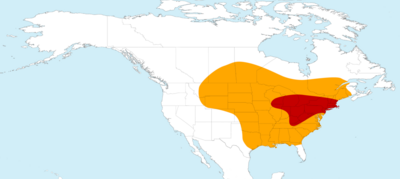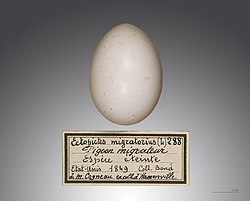Bird lore (1913) (14562557107)
Identifier: birdlore151913nati (find matches)
Title: Bird lore
Year: 1899 (1890s)
Authors: National Committee of the Audubon Societies of America National Association of Audubon Societies for the Protection of Wild Birds and Animals National Audubon Society
Subjects: Birds Birds Ornithology
Publisher: New York City : Macmillan Co.
Contributing Library: Smithsonian Institution Libraries
Digitizing Sponsor: Biodiversity Heritage Library
View Book Page: Book Viewer
About This Book: Catalog Entry
View All Images: All Images From Book
Click here to view book online to see this illustration in context in a browseable online version of this book.
Text Appearing Before Image:
nce an actual study of the Passenger Pigeon in the field is no longerpossible, information concerning its distribution and habits must be soughtfor in the records of former generations, and obtained from those yet livingwho knew the bird in its prime. Imperfect as this material is and difficult toprocure, the recent revival of interest in its tragic fate has brought to lightsufficient data to trace the life history of the race, and to fathom the causeswhich brought about its sudden and mysterious disappearance from the worldof the living. The habitat of the Pigeon, embracing as it did the vast native forest ofeastern North America, offered the bird a choice of food and residence, definiteregions thereof being occupied in proper season and in regular rotation. Eventhe fruits of the lowly herbs contributed to its bill of fare, and the handsomepoke-weed is locally known as Pigeon berry at the present day. But thebulk of its food consisted of the acorns of the numerous species of oak, the
Text Appearing After Image:
PASSENGER PIGEON, ADULT FEMALENote the characteristically erect pose (79) 80 Bird - Lore seeds of beech, chestnut, maple, elm, and other hardwoods, of pine and hem-lock, and of the fruits and berries of bushes and shrubs. Angleworms, snails,caterpillars, and soft-bodied insects, such as grasshoppers, helped to vary thevegetarian diet. From the frequent mineral springs and licks the bird grati-fied its craving for salt, a condiment eagerly sought by all grain feeders. The winter range of the bird comprised the territory south of Mason andDixons line, a land well stocked with its chief food supply during the inclementseasons. In one of these natural granaries the flocks would settle down andforage until the mast within a radius of two hundred miles and over had beenconsumed. While feeding in concert, the rear ranks successively rose and,passing over the whole flock, alighted in front, giving every bird an equalchance. Like an enormous wheel in slow motion, the birds moved through thewoo
Note About Images
Photograph of a female Passenger Pigeon (Ectopistes migratorius) in captivity from the year 1898.
Relevantní obrázky
Relevantní články
Holub stěhovavýHolub stěhovavý býval pravděpodobně nejhojnějším ptákem na Zemi. Obýval v obrovských hejnech původní listnaté lesy Severní Ameriky, východně od Skalnatých hor. Fosilie tohoto ptáka byly objeveny v pleistocénních uloženinách na území amerického Marylandu. Jejich počty dosahovaly tří až pěti miliard jedinců a odhaduje se, že tvořili 40 % všech severoamerických ptáků. Po osídlení Ameriky evropskými přistěhovalci byli loveni kvůli masu i pro zábavu, takže jejich počty rychle poklesly. Poslední divoce žijící holub stěhovavý byl zastřelen v roce 1900, poslední jedinec uhynul v roce 1914. .. pokračovat ve čtení





